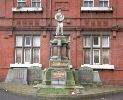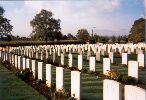
Newton-le-Willows and
Earlestown War Memorial

| LINKS |
MEMORIALS |
RESOURCES |
POSTCARDS |
OTHER WARS |
 |
Newton-le-Willows andEarlestown War Memorial |
 |
| The
Great War Roll of Honour |
|||||||||||||||||||||||||
| A |
B |
C |
D |
E |
F |
G |
H |
I |
J |
K |
L |
M |
N |
O |
P |
Q |
R |
S |
T |
U |
V |
W |
X |
Y |
Z |
Lieutenant Robert Claude Stone was the elder son of the late Tom Stone, of Newton Park, Newton-le-Willows, who was a noted athlete and sportsman on the 1880s. Like his father, Lieut. Stone was also a keen sportsman, a good shot and a fisherman according to the lengthy obituary published in the Newton and Earlestown Guardian on May 4th 1917.
Mr. Tom Stone went out to Calgary, Alberta, Canada, in 1888, and there married Constance, a daughter of Colonel Wainwright. Lieut. Stone, who was born in Calgary on September 20th 1891, came over to this country when he was six years old, with his mother and younger brother, and received his education at Grenfell’s Mostyn House School and Rugby School.
Taking up engineering as his profession, he became a premium pupil at the Vulcan Locomotive Works, Newton-le-Willows. In early 1912, he went to South Africa for the benefit of his health, and obtained a good appointment on the engineering staff of the Main Reef Consolidated Gold Mining Company. When labour troubles broke out on the Rand, he returned to England in the summer of 1913.
In June 1914, he went to Canada, to his native town of Calgary, and there obtained an engagement as Chief Engineer with a company developing oil wells. On the outbreak of war he enlisted in the Canadian Forces at Vancouver, B.C., on November 13th 1914. His Attestation Paper, taken from the Canadian Archives, says that he was six feet one inches tall, with a fresh complexion, grey eyes and brown hair. He had two medical scars. He stated he was a member of the Church of England.
Coming to England in the spring of 1915, he obtained a commission in the Special Reserve, and went to the front in October 1915. In February 1916, whilst in France, he obtained a commission in the Regular Army, the King’s Own (Royal Lancaster Regiment) and subsequently was attached to a Machine Gun Company. After taking part in several minor engagements, he was invalided home in May 1916.
In the autumn he returned to duty, training men for machine gun work at Grantham and Aldershot, and went out again to France in the middle of March 1917 as second in command of a Machine Gun Company.
Lieutenant Robert Claude Stone was killed on Easter Sunday 1917. A letter to his mother from an Officer in his company said: “… He and I had dinner together, and immediately after he went off with his groom on horseback to meet other officers, with the idea of reconnoitring a certain position. Whilst passing through a village behind the lines, a German shell dropped on the road a few yards from them, killing your son and another officer instantaneously, and wounding four others. Mr. Stone had taken over command of the Company that very morning.”
The obituary reported that “his younger brother, Lieut. W. G. Stone, of the Loyal North Lancashire Regiment, who has been out in France three times, and has seen a good deal of service, has now joined the 2nd Battalion of his Regiment in the East.”
Lieutenant R. C. Stone is buried in Chapelle
British Cemetery, Holnon, in Plot I Row A Grave 14. Holnon is a village
six kilometres west of St Quentin. The cemetery, which was named after a wayside
shrine, was made after the Armistice by the concentration of graves of 1917-18
from the battlefields west of St Quentin. It has over 600 1914-18 casualties
over whom over 250 are unidentified.